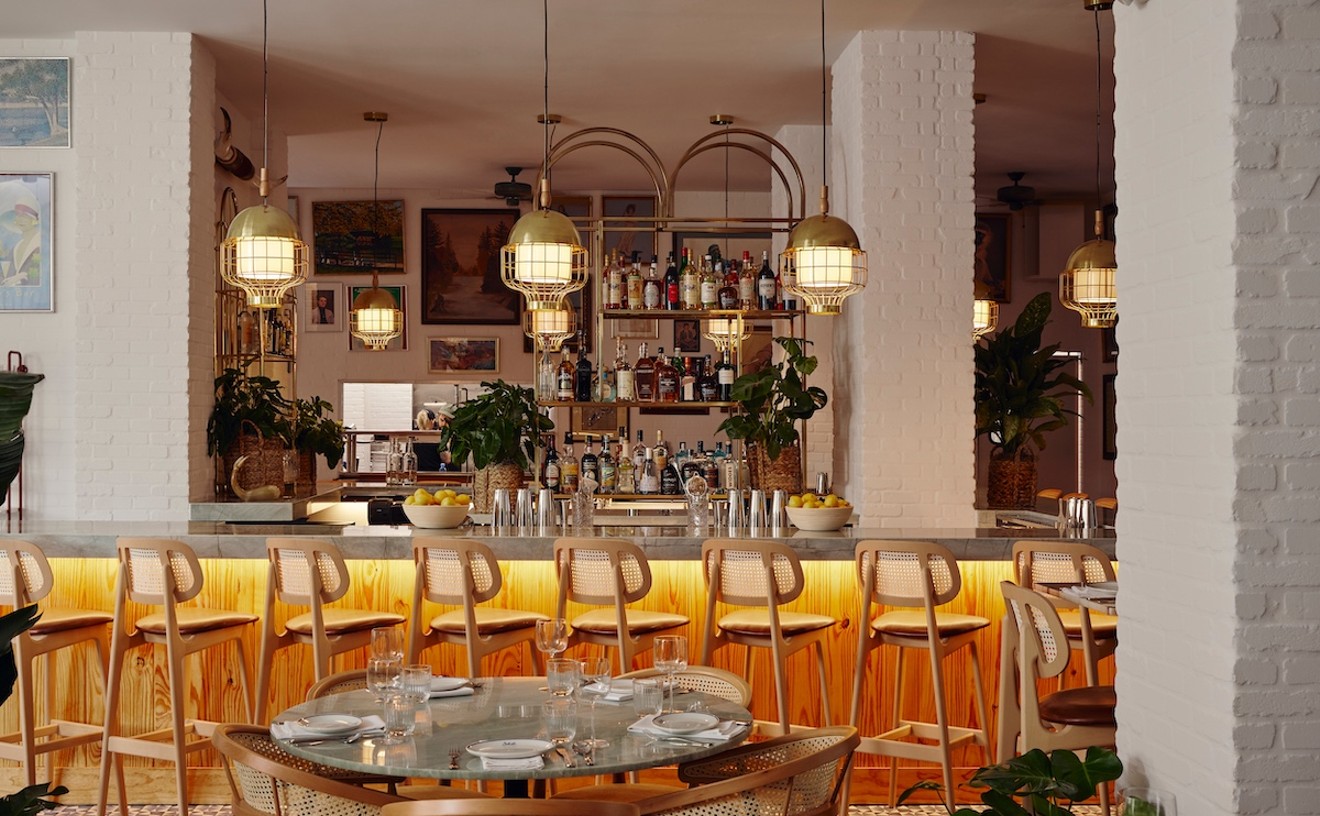The problem, it turns out, is that the Generation Xecutive has reached his account limit (probably from charging the expensive suit he's wearing), which naturally wouldn't have happened had he had the good sense to carry American Express. Unable to cover the bill, he is embarrassed in front of bosses, colleagues, and clients. The subtext of this particular advertising campaign is clear enough: Be prepared.
I can empathize with the guy. Most of my meals out are business dinners in one way or another, and I've had my share of mishaps. I've accidentally sent people to the wrong restaurant -- one friend waited in vain for me at Villa Havana while I went ahead and ate without him at Villa Habana. I've gotten irretrievably lost and left guests sitting for more than an hour. I've borrowed money from my companions when restaurants won't accept the credit cards I carry.
With experience come precautions. I double-check a restaurant's name, address, and phone number. Though I can't help but run on Jewish time and am sort of always a minute or two (or ten) late, I let my husband, who has a sense of direction like a migratory bird, do the driving. And I bring a pocketful of cash just in case. That way when I dine with people who have some say in my vocational life, as I did at the two-year-old Vietnamese and Chinese restaurant Little Saigon in North Miami Beach, certain factors are under my control.
The one variable whose outcome I can never predict, however, is the flair of the fare.
My guests on this recent night out were a current boss (Tom Finkel, my editor at New Times) and a former one (John Balaban, director of UM's creative writing program), and their wives. I always deliver a standard disclaimer when I sit down with a group at a restaurant I intend to review. I've never been here before, I say, and have no idea how good the food is. In this case, though, I didn't feel the need to address this concern: Tom and John had separately informed me about this place, rather than vice versa; it had come recommended to them as a great find. The kind of unassuming place, they were told, that serves authentic, freshly prepared, great food. The kind of place, in other words, that I'm always on the lookout for.
Our expectations were high. The 40-seat restaurant's clean, nondescript interior, tables simply set, walls painted seafoam green and hung with a few Oriental prints and other doodads, seemed a good sign. So was the diverse clientele, which included a fair number of Southeast Asians. And so was the scope of the Vietnamese menu, which sets forth a wide range of authentic dishes -- even drinks like salty lemonade and three-color bean paste with coconut milk. Sad to say, though, our meal didn't live up to the early promise.
Though Little Saigon does have a Chinese menu, you're not likely to see it unless you ask for it. We didn't bother; the Vietnamese menu we were given covered plenty of ground, and appealed to the pocketbook as well as the appetite. Some items we tried to order weren't available, though -- the restaurant was out of pork chops, and snails in black bean and pepper sauce had been taken off the menu because they didn't sell, our waiter told us. This was a little odd, according to John, who spent time in Vietnam as a conscientious objector during the war and later chronicled his experiences in his memoir Remembering Heaven's Face; snail dishes are common in Vietnam.
When we found out that an appetizer of tai heo (pig ear julienned and served cold) was available, John was more than willing to give it a go (I confess I ordered it mostly out of a sense of duty). Though he consumed plenty of it with interested enjoyment, to me the slices looked like pale shiitake mushrooms but tasted more like rubber bands, cartilage surrounded by a thin layer of skin. The strips were accompanied by nuoc mam gung, a salty ginger condiment spiked with garlic and fish sauce (nuoc mam), which gave the dish some flavor but couldn't make the texture palatable. Had my editor not been at the table with me, I might have gone so far as to spit this out.
Cha gio, deep-fried spring rolls, are often referred to as the national dish of Vietnam and are a common street food. These should be tasty little nuggets bursting with shrimp, vegetables, and ground pork. At Little Saigon, unfortunately, the greasy rice paper wrappers tasted old, as if the oil in which they'd been fried hadn't been changed recently. The filling -- minced pork, rice noodles, shredded carrot, and a speckle or two of tree ear mushrooms -- was virtually flavorless. A dip in nuoc cham, the ubiquitous Vietnamese sweet-and-sour sauce whose main ingredients are nuoc mam, garlic, sugar, lime juice, vinegar, and chilies, failed to improve matters; an insipid version, it was hardly tangy, barely sweet, and not at all spicy.
Rolled in rice paper wrappers but not fried, the iceberg lettuce and shredded pork interior of bi cuon, cousin to the spring rolls, were given a boost by pungent fresh coriander. Two to an order, these bundles were also somewhat bland, though a dark, rich peanut sauce helped obscure the uninspiring texture of the pork, which was dry and crunchy in places.
Goi ga, traditional Vietnamese chicken salad, was perhaps the most interesting appetizer we sampled, and certainly the most generous in terms of portion. Chopped cabbage, grated carrots, and thinly sliced onion marinated in a simple vinaigrette provided the base for the salad. Another dressing of nuoc cham and a sprinkling of shredded mint and coriander leaves provided some extra emphasis and gave the poached chicken, an ample quantity of which was arranged on top, a surge of flavor. The poultry was tender and juicy, though undercooked in some places to an alarming degree. We also found some chopped cartilage and gristle mixed in with the meat, as if the whole bird -- bones and all -- had been cleavered and served, an authentic "hacked-up quality" that appealed to my editor, who thought it not out of place in this mom-and-pop place, but which didn't thrill me.
Eleven varieties of pho, the chili-spiced broth frequently consumed for breakfast in Vietnam, were available. But hu tieu nam vang, a rice noodle soup stocked with shrimp, pork, and squid, was a bit of a disappointment. Also known as Saigon soup, the pork-and-chicken stock is frequently prepared with dried squid, which should give it a signature smoky flavor, and daikon radish, which absorbs the squid's salt and sweetens the whole affair. But we couldn't distinguish this broth from hot water, despite the slices of pork and pink shrimp curled in its depths. A nested base of rice noodles and side garnishes of bean sprouts, saw-toothed ngo gai (a type of coriander) leaves, and lime wedges were pleasant, but what this soup really needed was a sinus-clearing dose of chilies or chili oil.
In fact, spice seemed to be absent in just about everything we ordered -- appetizers, soup, and main courses alike. Fried tofu in particular was greaseless but bland, cubes of bean curd served on a bed of iceberg lettuce and requiring nuoc cham to entice at all. The salt-and-pepper sauce that dressed a squid dish had more body thanks to garlic and more nuoc mam, but the squid rings were so chewy as to be inedible. Another mouthful for the discreet napkin. Blue crabs sauteed in black bean sauce sounded and looked delicious, the hacked crab halves and claws glistening under a perfumed blanket of fermented soybeans afloat in a garlicky brown sauce. The sauce, though, proved to be the best part; the tiny crabs were overcooked and practically hollow, devoid of meat.
Neither Vietnamese nor Chinese, Singapore noodles seem to show up at every Asian restaurant, regardless of nationality. Little Saigon's version was a heaping serving, thin egg noodles (called vermicelli on the menu) wound through with strips of pork and shreds of snow peas, onions, and scallions. But the yellow curry that coated the ingredients tasted pre-prepared, like the shortcut ones you see on an Asian grocery's shelf. The result was pasty, the noodles curling aridly.
Beef with mustard greens was a late arrival, brought to the table well after everything else. Perhaps for that reason it was the most alluring. Or maybe it was because the slices of tender beef had been stir-fried with mustard greens and bits of Chinese broccoli, the latter adding a nice touch of bitterness to the mild, soy-salty brown sauce.
I'm a pessimist by nature, yet I'm an optimist when it comes to restaurants. The next one is always around the corner, always better than the last. In this case, that might well prove true: Dozens of Asian eateries abound in North Miami Beach, and I'll soon have another chance in this area. Of my two bosses, though, I couldn't tell who was more let down and who felt more responsible. But I can tell them this: With all due respect, next time I pick the place.
Little Saigon
16752 N Miami Ave, North Miami Beach; 653-3377. Open Monday -- Friday from noon to 1:00 a.m., Saturday from 5:00 p.m. to 1:00 a.m., and Sunday from noon to 11:00 p.m.
Cha gio
$3.00
Hu tieu nam vang
$5.95
Blue crabs in black bean sauce
$9.95
Beef with mustard greens
$7.95










